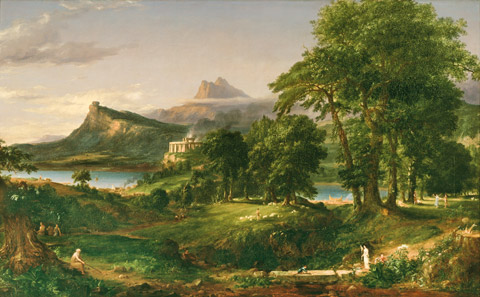
THE COURSE OF EMPIRE: THE ARCADIAN OR PASTORAL STATE The Hollywood-like spectacle of
Thomas Cole’s multi-canvas work is hard to resist. |
Niagara Falls cascades downwards in Louisa Davis Minot's folksy 1818 painting and, from the bottom, mist rises back up toward ominous skies. The painting, featured in the exhibit "Painting the American Vision" at the Peabody Essex Museum in Salem through November 6, portrays the awesome natural forces coursing through America.
>> SLIDESHOW: "Painting the American Vision" at the Peabody Essex; "Shifting Terrain: Landscape Video" at the Currier Museum of Art <<
"Painting the American Vision" — 45 rapturous paintings from the New York Historical Society — surveys the Hudson River School painters, dubbed for the upstate New York river where they spent their summers prospecting for sights to transform into ravishing canvases in their Manhattan studios each winter.
They emerged as America's first significant landscape painters during the first half of the 19th century, just as the nation was trying to come to grips with its young self. Fighting the British to a tie in the War of 1812 fostered a renewed democratic sense of a common stake in the land — especially for white guys in the East. Meanwhile, President Andrew Jackson in the 1830s ordered all Native Americans pushed west of the Mississippi.
Nature, formerly a place of "savages" and "witches," was where Transcendentalists now went to commune with God. Easterners felt so safe that James Fenimore Cooper had a hit with his 1826 novel The Last of the Mohicans, a nostalgic tale of the elimination of Eastern tribes. Europe counted its pedigree by its ancient ruins, whereas Hudson River art identified America as a land of wild natural resources. But the art was also suffused with nostalgia for woods felled by axes as America pursued its "Manifest Destiny."
"All nature here is new to art," professed Thomas Cole, the group's founding father. He painted many landscapes, but his standout project here is a five-canvas melodrama, The Course of Empire (1833-36), describing the rise of a gold-and-marble Rome out of a wilderness. Then war destroys everything, leaving a ruin reclaimed by trees and vines. Is it about the decline of the Federalists? Or "King Andrew" Jackson's expansion of presidential powers? Today it feels like Brad Pitt's Troy, but the blockbuster spectacle is hard to resist.
Albert Bierstadt's astonishing, 10-foot-wide 1873 canvas Donner Lake from the Summit concludes the exhibit. Trees dot rugged California mountains and a railway snakes along the cliffs. We're above the clouds as the sun rises. It's heaven on earth — or, as Bierstadt had proclaimed about Yosemite after a trip there in 1863, "the garden of Eden." Traveling west in 1859, Bierstadt photographed stereo views, which create a 3D experience. His paintings also aim to immerse you in the landscape — and they suggest that the ultimate legacy of the Hudson River gang's sublime panoramas is Hollywood.
Which brings us to "Shifting Terrain: Landscape Video" at the Currier Museum of Art in Manchester, New Hampshire (through September 18). Assistant curator Nina Bozicnik rounds up seven New England video artists with a contemporary look at the land. Most of the videos seem like formal experiments or illustrations of prefab concepts, but Louisa Conrad's Chores is a lyrical half-hour video diary of she and her husband working their Vermont sheep-and-goat farm. The video meanders through the seasons. A man leads goats through a snowy field. A goat licks her newborn baby's fur clean. Young goats suck milk from Coke bottles transformed into baby bottles. Conrad draws you in with a pastoral rhythm, and a willingness to follow where nature leads.
Read Greg Cook's blog at gregcookland.com/journal